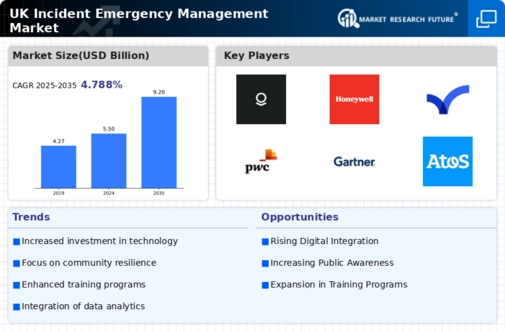Increased Investment in Infrastructure
The incident emergency-management market in the UK is experiencing a notable surge in investment aimed at enhancing infrastructure resilience. Government initiatives, such as the National Resilience Strategy, have allocated substantial funding to improve emergency response capabilities. This includes upgrading communication systems and emergency services facilities, which are crucial for effective incident management. The UK government has committed over £1 billion to bolster infrastructure against potential threats, indicating a strong focus on preparedness. As a result, the incident emergency-management market is likely to benefit from these investments, fostering innovation and the adoption of advanced technologies. Enhanced infrastructure not only improves response times but also increases public confidence in emergency services, thereby driving demand for comprehensive incident management solutions.
Growing Public Awareness and Preparedness
Public awareness regarding emergency preparedness is steadily increasing in the UK, significantly impacting the incident emergency-management market. Campaigns aimed at educating citizens about disaster readiness and response strategies have gained traction, leading to a more informed populace. According to recent surveys, approximately 70% of UK residents now acknowledge the importance of being prepared for emergencies. This heightened awareness is likely to drive demand for training programs and resources, as individuals seek to equip themselves with the necessary skills to respond effectively. Consequently, the incident emergency-management market is poised to expand as organizations develop tailored solutions to meet the needs of a more proactive public, fostering a culture of preparedness across communities.
Climate Change and Environmental Challenges
The increasing frequency of extreme weather events in the UK, attributed to climate change, is significantly influencing the incident emergency-management market. Flooding, storms, and heatwaves are becoming more prevalent, necessitating enhanced emergency response strategies. The UK government has recognized this challenge, allocating over £400 million for flood defense and resilience projects. This funding is aimed at improving infrastructure and response capabilities to mitigate the impacts of climate-related incidents. As environmental challenges continue to escalate, the incident emergency-management market is likely to expand, driven by the need for innovative solutions that address these emerging threats. Organizations are expected to invest in adaptive technologies and training programs to better prepare for and respond to climate-induced emergencies.
Legislative Support for Emergency Management
The legislative framework surrounding emergency management in the UK is evolving, providing robust support for the incident emergency-management market. Recent legislative measures have reinforced the responsibilities of local authorities and emergency services in disaster preparedness and response. The Civil Contingencies Act mandates that local councils develop comprehensive emergency plans, thereby creating a structured approach to incident management. This legal backing is likely to stimulate demand for specialized services and products within the market, as organizations seek to comply with regulatory requirements. Furthermore, the emphasis on collaboration among agencies is fostering partnerships that enhance resource sharing and operational efficiency. As a result, the incident emergency-management market is expected to grow in response to these legislative developments.
Advancements in Technology and Data Analytics
Technological advancements are playing a pivotal role in shaping the incident emergency-management market in the UK. The integration of data analytics, artificial intelligence, and machine learning into emergency response systems is enhancing decision-making processes. For instance, predictive analytics can forecast potential incidents, allowing for preemptive measures to be taken. The UK government has invested approximately £500 million in technology upgrades for emergency services, indicating a commitment to leveraging innovation for improved outcomes. These advancements not only streamline operations but also facilitate real-time communication and coordination among various agencies. As technology continues to evolve, the incident emergency-management market is likely to witness increased adoption of sophisticated tools that enhance overall efficiency and effectiveness in managing emergencies.






















Leave a Comment